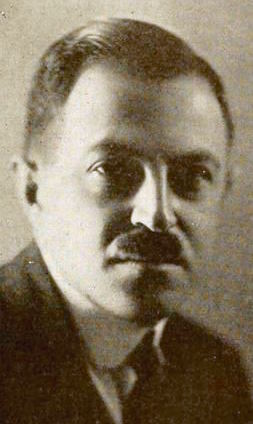Related Research Articles

Fleischer Studios was an American animation studio founded in 1929 by brothers Max and Dave Fleischer, who ran the pioneering company from its inception until its acquisition by Paramount Pictures, the parent company and the distributor of its films. In its prime, Fleischer Studios was a premier producer of animated cartoons for theaters, with Walt Disney Productions being its chief competitor in the 1930s.

Max Fleischer was a Polish-American animator and studio owner. Born in Kraków, Poland, Fleischer immigrated to the United States where he became a pioneer in the development of the animated cartoon and served as the head of Fleischer Studios, which he co-founded with his younger brother Dave. He brought such comic characters as Koko the Clown, Betty Boop, Popeye, and Superman to the movie screen, and was responsible for several technological innovations, including the rotoscope, the "follow the bouncing ball" technique pioneered in the Ko-Ko Song Car-Tunes films, and the "stereoptical process". Film director Richard Fleischer was his son.

Betty Boop is an animated cartoon character designed by Grim Natwick at the request of Dave Fleischer. She originally appeared in the Talkartoon and Betty Boop film series, which were produced by Fleischer Studios and released by Paramount Pictures. She was featured in 90 theatrical cartoons between 1930 and 1939. She has also been featured in comic strips and mass merchandising.

Talkartoons is a series of 42 animated cartoons produced by Fleischer Studios and distributed by Paramount Pictures from 1929 to 1932.
Color Classics are a series of animated short films produced by Fleischer Studios for Paramount Pictures from 1934 to 1941 as a competitor to Walt Disney's Silly Symphonies. As the name implies, all of the shorts were made in color format, with the first entry of the series, Poor Cinderella (1934), being the first color cartoon produced by the Fleischer studio. There were 36 shorts produced in this series.

Dave Fleischer was an American film director and producer who co-owned Fleischer Studios with his older brother Max Fleischer. He was a native of New York City.

The Old Man of the Mountain is a 1933 American pre-Code live-action/animated short in the Betty Boop series, produced by Fleischer Studios. Featuring music by Cab Calloway and his Orchestra, the short was originally released to theaters on August 4, 1933, by Paramount Pictures. Calloway voices all of the characters in the cartoon save for Betty herself. Calloway and his orchestra also perform all of the music in the cartoon, including two songs Calloway co-wrote.
The Swing School is a 1938 Fleischer Studios animated short film directed by Dave Fleischer and starring Betty Boop.

Musical Mountaineers is a 1939 Fleischer Studios animated short film starring Betty Boop.
Betty in Blunderland is a Fleischer Studios animated short film starring Betty Boop, which was released on the 6th of April in 1934. Also known as Betty in Flunkerland.
She Wronged Him Right is a 1934 Fleischer Studios animated short film starring Betty Boop. It marks the first appearance of Betty's semi-regular boyfriend, Fearless Fred.
Out of the Inkwell is a 1938 Max Fleischer/Betty Boop live-action and animated short film. The title and concept for the film were a tribute to the Out of the Inkwell series of films that Max Fleischer had produced during the 1920s.
Betty Boop's Museum is a 1932 Fleischer Studios animated short film starring Betty Boop, and featuring Koko the Clown and Bimbo.
Red Hot Mamma is a 1934 Fleischer Studios Betty Boop animated short directed by Dave Fleischer.

Christmas Comes But Once a Year is a 1936 animated short produced by Fleischer Studios and released on December 4, 1936 by Paramount Pictures. It is part of the Color Classics series. The cartoon features Professor Grampy, a character from the Betty Boop series; this is the character's only appearance without Betty. An edited version was featured during the Pee-wee's Playhouse Christmas Special in 1988, as the featured short shown by the King of Cartoons.

Popeye the Sailor is an American animated series of short films based on the Popeye comic strip character created by E. C. Segar. In 1933, Max and Dave Fleischer's Fleischer Studios, based in New York City, adapted Segar's characters into a series of theatrical cartoon shorts for Paramount Pictures. The plotlines in the animated cartoons tended to be simpler than those presented in the comic strips, and the characters slightly different. A villain, usually Bluto, makes a move on Popeye's "sweetie", Olive Oyl. The villain clobbers Popeye until he eats spinach, giving him superhuman strength. Thus empowered, Popeye makes short work of the villain.
Buzzy Boop is a 1938 Fleischer Studios animated short film in the Max Fleischer/Betty Boop Cartoon featuring Betty Boop and her young tomboy cousin Buzzy Boop.
Sally Swing is a 1938 Fleischer Studios animated short film in Max Fleischer's Betty Boop series. The short features the voice talents of Rose Marie as Sally Swing and Margie Hines as Betty Boop.
Buzzy Boop at the Concert is a 1938 Fleischer Studios animated short film starring Betty Boop's young tomboy cousin Buzzy Boop.

Minnie the Moocher is a 1932 Betty Boop cartoon produced by Fleischer Studios and released by Paramount Pictures.
References
- ↑ Scott, Keith (2022). Cartoon Voices from the Golden Age, 1930-70. BearManor Media. p. 346. ISBN 979-8-88771-010-5.
- ↑ Lenburg, Jeff (1999). The Encyclopedia of Animated Cartoons. Checkmark Books. pp. 54–56. ISBN 0-8160-3831-7 . Retrieved June 6, 2020.